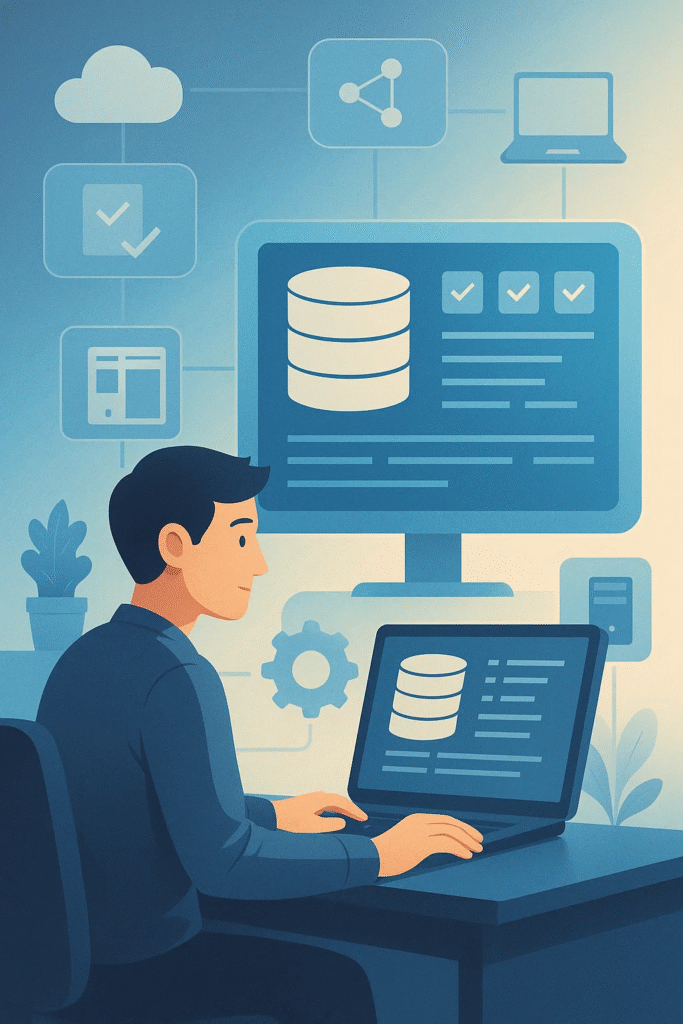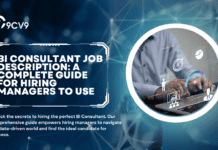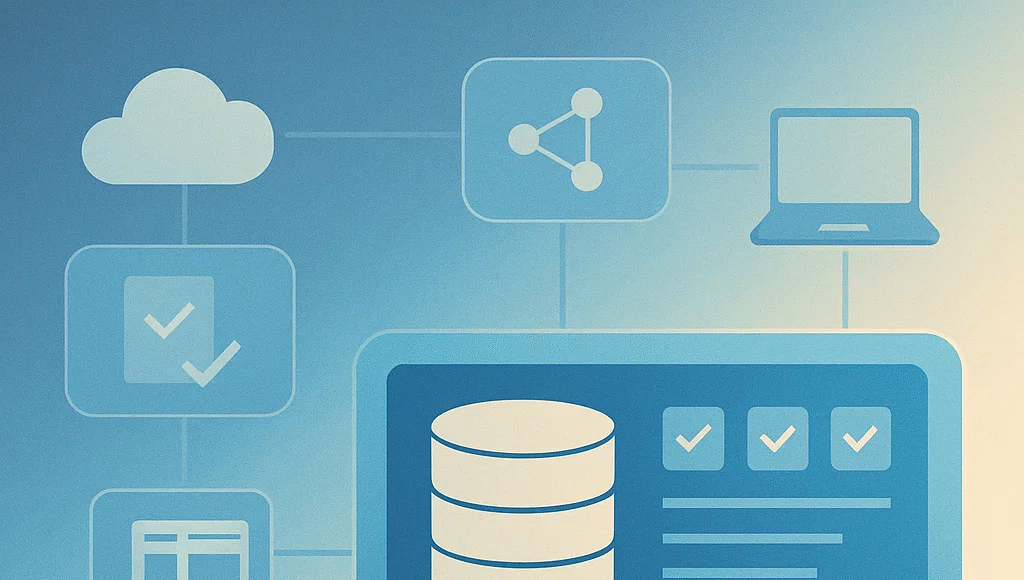Key Takeaways
- Comprehensive IT Asset Management – The best CMDB software in 2025 offers advanced features for tracking, managing, and optimizing IT infrastructure.
- Automation and AI Integration – Modern CMDB solutions leverage AI-driven automation to enhance accuracy, streamline workflows, and improve IT service management.
- Scalability and Flexibility – Top CMDB platforms provide seamless integrations, cloud compatibility, and customizable configurations to meet diverse business needs.
In today’s rapidly evolving digital landscape, businesses must effectively manage their IT assets, infrastructure, and services to maintain operational efficiency and ensure seamless service delivery.
Configuration Management Database (CMDB) software plays a critical role in this process by providing organizations with a centralized repository to store, track, and manage configuration items (CIs) such as hardware, software, networks, and documentation.
As IT environments become more complex and interconnected, leveraging advanced CMDB solutions has become essential for enterprises looking to optimize IT service management (ITSM), reduce downtime, and improve decision-making.

The importance of CMDB software has significantly increased as organizations continue to embrace digital transformation, cloud computing, and hybrid IT infrastructures.
Modern CMDB solutions go beyond simple asset tracking and offer powerful features such as automated discovery, real-time updates, change management, relationship mapping, and integration with IT service management (ITSM) tools like ITIL frameworks.
These capabilities allow businesses to gain a comprehensive view of their IT ecosystem, enabling them to proactively address potential issues, streamline workflows, and enhance overall IT governance.
Selecting the right CMDB software in 2025 is crucial for organizations aiming to improve IT visibility, enhance security compliance, and optimize resource allocation.
With numerous solutions available in the market, choosing the best CMDB software can be challenging. Businesses must consider key factors such as ease of integration, automation capabilities, data accuracy, reporting functionalities, and support for cloud and hybrid environments.
Additionally, AI-driven insights, predictive analytics, and automated remediation features are becoming increasingly valuable for organizations seeking to minimize risks and improve IT resilience.
This article explores the top 10 best CMDB software solutions in 2025, highlighting their features, benefits, and how they can help businesses effectively manage their IT assets and configurations. Whether you are a large enterprise, a mid-sized organization, or an IT service provider, finding the right CMDB software can significantly impact your ability to maintain IT stability, reduce operational costs, and drive digital transformation. Read on to discover the leading CMDB tools that can enhance your IT asset management strategy and ensure seamless business continuity in 2025.
Before we venture further into this article, we would like to share who we are and what we do.
About 9cv9
9cv9 is a business tech startup based in Singapore and Asia, with a strong presence all over the world.
With over nine years of startup and business experience, and being highly involved in connecting with thousands of companies and startups, the 9cv9 team has listed some important learning points in this overview of the Top 10 Best Configuration Management Database (CMDB) Software in 2025.
If your company needs recruitment and headhunting services to hire top-quality employees, you can use 9cv9 headhunting and recruitment services to hire top talents and candidates. Find out more here, or send over an email to [email protected].
Or just post 1 free job posting here at 9cv9 Hiring Portal in under 10 minutes.
Top 10 Best Configuration Management Database (CMDB) Software in 2025
- ServiceNow
- BMC Helix
- SolarWinds Service Desk
- Device42
- Freshservice
- ManageEngine ServiceDesk Plus
- InvGate Insight
- Jira Service Management
- CMDBuild
- OpenText Service Management
1. ServiceNow

ServiceNow CMDB stands as one of the most powerful and widely adopted Configuration Management Database (CMDB) solutions in 2025, renowned for its enterprise-grade scalability, extensive integrations, and AI-driven automation. As part of the ServiceNow IT Service Management (ITSM) suite, this cloud-based platform delivers a comprehensive and dynamic system of record for IT assets, providing organizations with unparalleled visibility into their IT infrastructure. With its advanced discovery capabilities, ServiceNow CMDB ensures real-time and accurate asset tracking, allowing businesses to maintain up-to-date records of their IT components, relationships, and dependencies.
A standout feature of ServiceNow CMDB is its AI-powered asset discovery and automation, which eliminates manual tracking and significantly enhances data accuracy. The platform continuously scans IT environments to identify and map assets, automatically updating the database to reflect any changes. This proactive approach reduces configuration errors, minimizes downtime, and strengthens IT governance. Furthermore, ServiceNow’s sophisticated service mapping functionality enables organizations to visualize complex interdependencies between applications, infrastructure, and business services, facilitating faster troubleshooting and more efficient incident management.
Beyond its core CMDB capabilities, ServiceNow excels in seamless integration with ITSM, IT operations management (ITOM), and cloud platforms, creating a unified ecosystem for IT management. It supports a broad range of integrations with third-party tools, enabling organizations to consolidate IT processes and enhance overall operational efficiency. The platform’s customizable workflows, advanced reporting features, and role-based access controls offer enterprises the flexibility to tailor their IT asset management approach while ensuring robust security and compliance.
ServiceNow CMDB is particularly well-suited for large enterprises managing complex IT environments. Its ability to function as a single source of truth for IT infrastructure helps organizations gain deeper insights into their entire IT ecosystem, improving risk assessment, capacity planning, and decision-making. However, while the platform offers an extensive feature set, potential drawbacks include high implementation costs and a steep learning curve, making it more suitable for organizations with the necessary resources and expertise to maximize its capabilities.
Despite these challenges, ServiceNow CMDB maintains a strong market presence and an outstanding reputation, consistently receiving high ratings from users. According to PeerSpot, ServiceNow CMDB holds an impressive rating of 8.6 out of 10, reflecting widespread user satisfaction with its comprehensive feature set and scalability. Additionally, with a market mindshare of 41.6%, it dominates the CMDB landscape, making it a preferred choice for enterprises seeking a highly reliable and future-proof IT asset management solution.
By delivering intelligent automation, real-time asset tracking, and deep integration with IT management frameworks, ServiceNow CMDB continues to be a leading solution in 2025, empowering organizations to enhance IT operations, optimize service delivery, and maintain resilient and efficient IT infrastructures.
2. BMC Helix

BMC Helix CMDB is a highly sophisticated and enterprise-grade Configuration Management Database (CMDB) solution designed to support modern IT environments, particularly those operating across hybrid and multi-cloud infrastructures. As part of the broader BMC Helix ITSM suite, this platform provides organizations with a centralized and intelligent repository for managing IT assets, configurations, and dependencies, ensuring seamless visibility and control over complex IT landscapes.
One of BMC Helix CMDB’s most distinguishing features is its advanced data modeling and visualization capabilities, which allow IT teams to construct an accurate and dynamic representation of their IT ecosystem. With automated dependency mapping, organizations can identify critical relationships between IT components, applications, and services, enabling faster root-cause analysis, improved impact assessments, and more effective change management. This functionality enhances operational efficiency, reduces downtime, and minimizes the risks associated with unplanned changes.
BMC Helix CMDB also prioritizes compliance and governance, making it an excellent choice for organizations operating in highly regulated industries. The platform automates compliance-related tasks, ensuring adherence to ITIL best practices for asset tracking, change management, and service impact analysis. By serving as a single source of truth for IT asset relationships, the solution helps organizations mitigate security risks, enhance regulatory compliance, and establish a more structured approach to IT operations.
Another key advantage of BMC Helix CMDB is its ability to consolidate and federate data from multiple sources, effectively addressing the common challenge of data silos in large IT environments. By integrating information from various asset repositories, cloud services, and on-premise infrastructure, it provides organizations with a holistic, real-time view of their entire IT landscape. This data-driven approach enables better decision-making, proactive problem resolution, and enhanced IT service management (ITSM) outcomes.
Despite its extensive capabilities, BMC Helix CMDB does come with certain challenges. The implementation and configuration process can be complex, requiring a well-structured deployment strategy and skilled IT personnel. Additionally, its pricing model may be a consideration for some organizations, as the platform is primarily designed for mid-sized to large enterprises with more sophisticated IT management needs. However, the long-term benefits of enhanced IT visibility, improved operational efficiency, and reduced compliance risks often outweigh these challenges, making it a worthwhile investment for organizations seeking a comprehensive and scalable CMDB solution.
User feedback for BMC Helix CMDB remains overwhelmingly positive, with a high recommendation rating of 89%, according to Infotech research data. Many users commend the platform’s accuracy in IT asset management, its deep integration capabilities, and its ability to streamline IT service operations.
As a cloud-native solution with a strong reputation for delivering advanced automation, real-time dependency mapping, and regulatory compliance support, BMC Helix CMDB continues to be a leading choice in 2025 for enterprises seeking a highly effective and intelligent IT asset management solution.
3. SolarWinds Service Desk

SolarWinds Service Desk CMDB is a cloud-based IT Service Management (ITSM) solution that integrates powerful Configuration Management Database (CMDB) functionality, making it an excellent choice for organizations looking to streamline IT asset and configuration management. Designed with an intuitive user interface and robust data visualization tools, this solution enables IT teams to efficiently track, manage, and analyze critical IT infrastructure components.
One of its core strengths lies in its automated asset discovery and tracking capabilities, which significantly reduce manual data entry and ensure an up-to-date, accurate inventory of IT assets. This feature is complemented by relationship mapping, which provides organizations with a clear view of how different assets interact within the IT environment. By visualizing these dependencies, IT teams can perform impact analysis to assess how changes to a specific asset might affect users, systems, and service delivery. This proactive approach minimizes downtime, optimizes incident resolution, and enhances overall operational efficiency.
A key advantage of SolarWinds Service Desk CMDB is its integration with incident, problem, and change management processes, allowing organizations to link configuration items (CIs) to specific incidents or problems. This integration enhances troubleshooting efforts, helping IT teams quickly identify recurring issues and implement effective resolutions. Additionally, its seamless compatibility with other SolarWinds IT management tools, such as network performance and server monitoring solutions, provides a comprehensive IT infrastructure management experience.
The platform also includes robust reporting and analytics tools, which allow organizations to extract valuable insights from their IT asset inventory. Customizable reporting capabilities enable businesses to track asset performance, analyze historical data, and optimize IT investments. Moreover, the inclusion of a knowledge base management feature ensures that employees have easy access to self-service resources, improving overall IT service efficiency and reducing workload on IT teams.
While SolarWinds Service Desk CMDB is a versatile and feature-rich solution, it is particularly well-suited for small to medium-sized businesses (SMBs) that require a cost-effective yet powerful CMDB. Although it may not offer the same level of depth as enterprise-grade CMDBs like ServiceNow or BMC Helix, it still provides a strong foundation for IT asset and configuration management, making it a valuable choice for organizations seeking a scalable and user-friendly CMDB solution.
Key Features of SolarWinds Service Desk CMDB
- Centralized Asset Repository: Stores comprehensive details of IT assets, including hardware, software, network devices, and non-IT assets, ensuring a unified view of the IT landscape.
- Automated Asset Discovery: Integrates with SolarWinds’ network monitoring tools to automatically detect and register IT assets, reducing the burden of manual data entry.
- Dependency Mapping & Visualization: Graphically represents relationships between assets, helping organizations understand dependencies for better impact assessment and troubleshooting.
- CI Record Management: Enables IT teams to create, track, and manage configuration items (CIs) with essential attributes such as device type, ownership details, and lifecycle status.
- Integration with Incident & Problem Management: Links configuration items to service tickets, allowing for faster root-cause analysis and improved resolution times.
- Change Management Integration: Assists in assessing the potential impact of changes on IT assets and services, enhancing risk mitigation and change planning.
- Customizable CI Types & Categories: Offers predefined categories like Computers, Servers, Software, and Network Devices, with the flexibility to create custom categories based on organizational needs.
- Reporting & Analytics: Provides customizable reports and dashboards, helping IT teams monitor asset performance, track service requests, and optimize IT spending.
- Search & Filtering Capabilities: Facilitates quick retrieval of specific configuration items based on asset attributes, service dependencies, or operational status.
- Basic Asset Lifecycle Management: Tracks the lifecycle stages of IT assets, from deployment and maintenance to retirement.
Limitations to Consider
While SolarWinds Service Desk CMDB offers extensive functionality, it may not be as feature-rich as enterprise-level CMDBs. Some of its limitations include:
- Less Comprehensive Discovery Capabilities: Automated asset discovery may not be as detailed as those found in more advanced CMDB solutions.
- Limited Service Mapping: While it provides relationship visualization, it lacks the automated service mapping sophistication available in high-end CMDB platforms.
- Basic Data Reconciliation: The platform may not support advanced data reconciliation features for aggregating and cleansing data from multiple sources.
- Restricted Data Governance Features: It offers basic compliance tracking but lacks granular governance controls for data certification and validation.
Why SolarWinds Service Desk CMDB is Among the Best in 2025
SolarWinds Service Desk CMDB continues to be a top choice in 2025 due to its intuitive design, cost-effective pricing, and seamless integration with other ITSM tools. Its ability to simplify IT asset tracking, enhance incident and change management, and provide meaningful data insights makes it particularly beneficial for SMBs and growing enterprises looking for an affordable yet powerful CMDB solution.
Additionally, with a starting price of $19 per user per month, it remains one of the most competitively priced CMDB platforms available. User reviews have consistently praised its ease of use, strong reporting capabilities, and efficient service management features, earning it a 4.6 out of 5 rating on GetApp.
For organizations seeking a cloud-based CMDB that delivers essential IT asset management functionalities without excessive complexity, SolarWinds Service Desk CMDB stands out as a leading solution in 2025.
4. Device42

Device42 stands out as one of the most powerful and versatile Configuration Management Database (CMDB) solutions in 2025, offering an advanced approach to IT asset discovery, dependency mapping, and infrastructure visualization. Designed to cater to organizations with complex IT ecosystems, Device42 excels in automated discovery and real-time infrastructure tracking, making it an indispensable tool for businesses managing diverse IT environments.
Following its acquisition by Freshworks in June 2024, Device42 has been seamlessly integrated into the Freshworks ecosystem, further enhancing its capabilities by aligning with modern IT service management (ITSM) requirements. This integration enables organizations to leverage Freshworks’ suite of ITSM tools, strengthening their overall IT infrastructure management strategy.
Key Features That Make Device42 a Top CMDB Solution
1. Agentless Auto-Discovery for Real-Time IT Asset Management
One of Device42’s standout capabilities is its agentless auto-discovery feature, which automatically detects and manages Configuration Items (CIs) across hybrid and multi-cloud environments. Unlike traditional CMDB solutions that rely on manual input or agent-based discovery, Device42 ensures that all IT assets—including physical, virtual, and cloud-based resources—are continuously monitored and updated. This feature significantly reduces the risk of outdated or inaccurate inventory records.
2. Advanced Dependency Mapping for Incident and Change Impact Analysis
Device42 excels in dependency mapping, a critical function for IT teams seeking to understand the interconnections between different assets. By visualizing relationships between servers, databases, applications, and network devices, it enables IT teams to conduct impact assessments for changes, incidents, and upgrades efficiently. This capability helps in identifying potential risks before implementing changes, reducing system downtime and enhancing IT service reliability.
3. Intelligent IT Infrastructure Visualization
Device42 offers a highly detailed and interactive visualization suite, which includes:
- Data Center Layout Views – Graphical representations of racks, power distribution units (PDUs), and hardware components for efficient data center management.
- IP Address Management (IPAM) – Centralized tracking and management of IP addresses across on-premises and cloud environments.
- Application and Network Topology Mapping – Enables teams to quickly identify bottlenecks, weak points, and potential risks within IT infrastructure.
These features make it significantly easier for IT teams to manage large-scale, distributed environments while maintaining visibility into asset relationships.
4. Seamless Integration with Leading ITSM and DevOps Tools
Device42 integrates effortlessly with industry-leading IT service management (ITSM) platforms and DevOps tools, enabling smooth workflows and enhanced automation. Supported integrations include:
- JIRA, ServiceNow, and Freshworks ITSM – Allows organizations to link asset data directly to incident, problem, and change management processes.
- Cloud Platforms (AWS, Azure, Google Cloud) – Ensures real-time synchronization of cloud-based assets and services.
- RESTful APIs – Enables businesses to create custom integrations with third-party applications, ensuring flexibility and adaptability.
5. AI-Powered Data Standardization with EnrichAI
Device42 leverages artificial intelligence (AI) to enhance CMDB accuracy through its proprietary EnrichAI feature. This AI-driven functionality standardizes CI attributes, cleans data inconsistencies, and enhances classification, ensuring that organizations have a single source of truth for their IT assets. This is particularly beneficial for enterprises struggling with data silos and fragmented infrastructure records.
Why Device42 is Among the Best CMDB Solutions in 2025
Device42 is a compelling CMDB solution for mid-sized businesses and enterprises that require scalable, automated, and highly visual IT asset management. Its primary advantages include:
- Unparalleled Auto-Discovery Capabilities – Eliminates the need for manual asset tracking by offering real-time updates on IT infrastructure.
- Strong Focus on Hybrid IT Environments – Supports both on-premises and cloud-based deployments, making it a versatile choice for modern enterprises.
- Ease of Integration – Works seamlessly with ITSM, DevOps, and cloud platforms, ensuring a well-connected IT management ecosystem.
- AI-Driven Data Optimization – Improves CMDB accuracy and efficiency, reducing errors and inconsistencies in asset records.
- Comprehensive Visualization Tools – Enhances IT operations and incident management with detailed graphical insights.
Pricing and User Reviews
Device42 offers flexible deployment options, available for both cloud and on-premises implementations, with a starting price of $1,499 per year. It has received high praise from IT professionals, particularly for its agentless discovery, intuitive asset management, and integration capabilities. On PeerSpot, Device42 holds an impressive rating of 8.3, placing it among the top-rated CMDB solutions in 2025.
Final Verdict
For organizations seeking an enterprise-grade CMDB solution with advanced discovery, AI-powered optimization, and seamless ITSM integration, Device42 is an exceptional choice. Its ability to map complex IT environments with minimal manual intervention makes it a top contender in the CMDB market, particularly for businesses operating in hybrid and multi-cloud landscapes.
5. Freshservice

Freshservice CMDB, developed by Freshworks, is a leading cloud-based Configuration Management Database (CMDB) solution designed to streamline IT asset and service management. Known for its intuitive interface, rapid deployment, and seamless automation capabilities, Freshservice offers organizations a sophisticated yet user-friendly platform for maintaining an accurate and up-to-date inventory of hardware, software, cloud resources, and services.
What sets Freshservice CMDB apart is its commitment to ITIL 4-compliant best practices, making it a strategic asset for organizations aiming to enhance incident, problem, and change management workflows. With AI-powered insights, automated discovery, and intelligent relationship mapping, Freshservice CMDB enables IT teams to gain complete visibility into their infrastructure while optimizing asset management and service delivery.
Key Features That Make Freshservice a Top CMDB Solution in 2025
1. Centralized Configuration Item (CI) Repository for Accurate IT Asset Management
Freshservice CMDB serves as a single source of truth for IT infrastructure by maintaining a structured and comprehensive database of Configuration Items (CIs). It supports a wide range of asset types, including:
- Physical and virtual servers
- Network devices and endpoints
- Cloud resources (AWS, Azure, GCP)
- Software applications and services
- Business-critical non-IT assets
This centralized repository ensures that organizations maintain complete visibility and control over their IT landscape, reducing inefficiencies caused by fragmented asset tracking.
2. AI-Driven Automated Discovery for Real-Time Asset Tracking
Freshservice simplifies IT asset management with its automated discovery tool, Discovery Probe, which continuously scans and identifies on-premises and cloud-based assets. This reduces the need for manual data entry, ensuring that CMDB records are always accurate, consistent, and up to date.
Additionally, Freshservice offers:
- Agent-Based Discovery (Optional) – For deeper visibility into software configurations, installed applications, and endpoint monitoring.
- Cloud Discovery – Seamless integration with AWS, Azure, and Google Cloud for automated tracking of cloud-based resources.
- Manual CI Creation – Allows IT teams to define and manage logical entities, business applications, and other non-discoverable assets.
3. Intelligent Relationship Mapping for Incident and Change Management
One of Freshservice CMDB’s most powerful capabilities is its relationship mapping feature, which enables organizations to visualize dependencies between assets, applications, and services. This is critical for:
- Impact Analysis – Helps IT teams assess how changes to one CI could affect other dependent systems.
- Root Cause Analysis – Speeds up troubleshooting by identifying interconnected assets that may be contributing to an issue.
- Service Mapping – Establishes clear relationships between IT infrastructure components and the business services they support, improving overall service management.
With graphical visualization tools such as CMDB Explorer, users can interactively explore relationships between different assets in an intuitive and user-friendly format.
4. Seamless ITSM Integration for Enhanced Incident, Problem, and Change Management
Freshservice CMDB is designed to work seamlessly with IT Service Management (ITSM) processes, allowing IT teams to link CIs directly to incidents, problems, and changes. Key integrations include:
- Incident Management – When logging incidents, users can associate affected assets to provide technicians with contextual insights.
- Problem Management – Helps identify recurring issues related to specific CIs, improving long-term IT service reliability.
- Change Management – Assesses the impact of proposed changes on dependent assets, reducing the risk of service disruptions.
By integrating CMDB data with ITSM workflows, Freshservice ensures that organizations can proactively manage IT issues and prevent system downtime.
5. AI-Powered Insights and Predictive Analytics for Optimized Asset Management
Freshservice leverages artificial intelligence (AI) and machine learning to provide actionable insights into CI health, performance, and lifecycle trends. The platform’s AI-driven features help IT teams:
- Benchmark CI performance to optimize asset lifespan.
- Receive proactive alerts about asset failures or misconfigurations.
- Identify inefficiencies in IT infrastructure to improve resource allocation.
With customizable alerts and notifications, Freshservice allows IT teams to stay ahead of potential issues before they escalate into critical failures.
6. Advanced Asset Lifecycle Management and Data Reconciliation
Beyond traditional CMDB functionality, Freshservice enables organizations to track IT assets throughout their entire lifecycle, from procurement to retirement. This includes:
- Automated status updates for assets as they transition through different lifecycle stages.
- Historical tracking of configuration changes, ensuring a detailed audit trail.
- Duplicate CI detection and data reconciliation, preventing inconsistencies in the CMDB.
By maintaining a historical record of CI changes, organizations can audit past modifications, revert to previous configurations, and ensure compliance with IT governance policies.
7. Intuitive User Experience with Multi-Channel Support
Unlike traditional CMDB solutions that require extensive training, Freshservice is renowned for its modern, intuitive interface that simplifies CMDB management for IT teams. Additionally, it provides multi-channel support, enabling users to interact with the system via:
- Web and mobile platforms
- Chatbots and AI-powered virtual assistants
- Email and service portals
This emphasis on usability makes Freshservice one of the most accessible CMDB solutions for organizations that lack dedicated IT asset management expertise.
Why Freshservice CMDB is a Leading Choice in 2025
Freshservice CMDB is an ideal choice for IT teams, Managed Service Providers (MSPs), and growing enterprisesseeking a cost-effective, cloud-based CMDB with automation-driven asset management. Its core strengths include:
- Rapid deployment with minimal technical complexity
- Seamless ITSM and AI-powered automation capabilities
- Scalable architecture suited for small to enterprise-level businesses
- Strong focus on ITIL 4 best practices and compliance
Additionally, user reviews highlight its ease of use and automation features, with 86% of Gartner reviewers recommending the platform.
Pricing and Deployment Options
As a fully cloud-based solution, Freshservice CMDB is designed for ease of access and scalability. The platform follows a flexible pricing model, starting at $29 per user per month, making it an affordable yet feature-rich CMDB option for organizations of all sizes.
Final Verdict
For businesses seeking a modern, AI-driven CMDB that combines powerful automation with an intuitive user experience, Freshservice CMDB stands out as one of the best choices in 2025. Its ability to simplify IT asset discovery, enhance ITSM integration, and provide intelligent insights makes it a highly recommended solution for companies aiming to streamline IT operations and improve service reliability.
6. ManageEngine ServiceDesk Plus

ManageEngine ServiceDesk Plus CMDB stands out as one of the most comprehensive and feature-rich configuration management database (CMDB) solutions available in 2025. Designed as part of an enterprise-grade IT service management (ITSM) platform, this CMDB tool seamlessly integrates with critical IT operations while maintaining strict adherence to ITIL best practices. It empowers organizations with a centralized and structured approach to managing their IT assets, their interdependencies, and the impact of changes within the IT environment.
What makes ManageEngine ServiceDesk Plus CMDB a top-tier solution is its ability to provide end-to-end asset visibility, robust relationship mapping, and integrated change management workflows—all within a single platform. With an extensive array of automation and analytics capabilities, this CMDB tool is particularly well-suited for mid-sized businesses and large enterprises looking to enhance IT operations, improve service efficiency, and reduce risks associated with IT asset mismanagement.
Key Features That Make ManageEngine ServiceDesk Plus CMDB One of the Best in 2025
1. Centralized Configuration Management for IT Assets
- Acts as a single source of truth for all IT assets, including hardware, software, cloud resources, and network devices.
- Enables IT teams to track, manage, and update assets throughout their lifecycle, from procurement to retirement.
- Provides a well-structured repository of Configuration Items (CIs) with detailed attributes, ensuring asset data accuracy.
2. Automated Asset Discovery and Inventory Management
- Offers automated IT asset discovery to identify and populate the CMDB with hardware and software assets across networks.
- Supports real-time asset tracking, reducing manual effort while maintaining an up-to-date inventory.
- Provides version control for hardware and software, enabling organizations to track changes and updates efficiently.
3. Advanced CI Relationship Mapping and Impact Analysis
- Establishes clear dependency mapping between CIs, providing a visual representation of interconnections among IT assets.
- Helps organizations analyze the impact of changes before implementation, reducing the risk of system failures.
- Enables IT teams to perform root cause analysis by tracing incidents back to their originating assets.
4. Seamless ITIL-Compliant Incident and Problem Management
- Fully integrates with incident and problem management modules, allowing technicians to quickly identify and resolve issues.
- Facilitates proactive problem identification by linking recurring incidents to specific CIs, minimizing service disruptions.
- Enhances service desk efficiency by prioritizing incidents based on asset criticality and impact.
5. Streamlined Change and Release Management
- Integrates CMDB data with change management workflows, enabling risk assessment before implementing changes.
- Supports customizable approval processes to ensure that changes do not negatively impact critical IT infrastructure.
- Helps organizations enforce compliance with IT governance and reduce unplanned downtime caused by poorly executed changes.
6. Compliance, Auditing, and IT Governance
- Offers comprehensive auditing tools to track modifications made to CIs, ensuring accountability.
- Helps businesses maintain regulatory compliance by providing a transparent record of IT asset changes.
- Supports organizations in meeting industry standards related to IT asset tracking and cybersecurity.
7. Intuitive User Interface and Flexible Deployment Options
- Designed with a user-friendly and structured interface that simplifies CMDB navigation and data visualization.
- Available in both cloud and on-premises deployment, providing businesses with flexibility based on their IT infrastructure.
- Offers a cost-effective pricing model, starting at $1,195 per year or $10 per month, making it accessible for a wide range of enterprises.
Why Organizations Choose ManageEngine ServiceDesk Plus CMDB
The primary advantages of ManageEngine ServiceDesk Plus CMDB lie in its comprehensive feature set, strong ITIL alignment, and seamless integration with ITSM functionalities. This makes it an excellent choice for organizations seeking a scalable and centralized CMDB solution to streamline IT operations.
- Enhanced Incident Response: By linking incidents to affected CIs, IT teams can quickly pinpoint the root cause of issues and accelerate resolution times.
- Improved Asset Utilization: Organizations can optimize asset usage by maintaining a complete view of IT infrastructure components.
- Reduced Service Downtime: Proactive risk assessment and dependency mapping help mitigate potential disruptions before they occur.
- Regulatory Compliance: The platform ensures that IT teams meet industry regulations by maintaining an auditable record of asset changes.
Despite its many strengths, some users have noted areas for improvement in its graphical interface and change management capabilities. However, its rich set of features, combined with its ITIL-compliant architecture, makes it one of the most reliable and cost-effective CMDB solutions available in 2025.
For businesses looking for a highly configurable, automation-driven, and ITIL-aligned CMDB, ManageEngine ServiceDesk Plus CMDB remains a top choice in the evolving IT landscape.
7. InvGate Insight

InvGate Insight has emerged as one of the top configuration management database (CMDB) solutions in 2025, offering a no-code, highly visual, and automation-driven approach to IT asset management. As organizations increasingly prioritize real-time IT visibility, streamlined configuration tracking, and compliance management, InvGate Insight stands out with its automated discovery, intuitive relationship mapping, and seamless integrationwith service management processes.
What makes InvGate Insight a top contender in the CMDB space is its ability to provide a fully unified view of IT infrastructure—from on-premises assets to cloud resources and IoT devices—all while eliminating redundancies through real-time data normalization. Its AI-powered service request management, change control functionalities, and compatibility with third-party monitoring tools further enhance its position as a leading solution for organizations of all sizes.
Key Features That Make InvGate Insight One of the Best CMDB Software in 2025
1. Advanced Automated Discovery and IT Asset Visualization
- Comprehensive IT asset detection: InvGate Insight automatically scans, identifies, and maps all configuration items (CIs) across an organization’s IT infrastructure, including servers, software applications, network devices, and cloud resources.
- Interactive CMDB maps: The platform generates dynamic visual representations of IT assets, helping organizations understand the relationships and dependencies between critical components.
- Real-time data normalization: By eliminating duplicates and inconsistencies, the system ensures a clean, organized, and reliable CMDB for more effective IT decision-making.
2. No-Code Customization for Seamless IT Service Management
- User-friendly no-code interface: Unlike complex traditional CMDB platforms, InvGate Insight enables IT teams to customize workflows, dashboards, and asset categorization without requiring coding expertise.
- Integration with service management: Connecting the CMDB with InvGate Service Management accelerates incident response, facilitates problem resolution, and supports proactive root cause analysis.
- Change management automation: The CMDB integrates with IT change management workflows to assess risks, track modifications, and prevent disruptions before deploying updates.
3. Comprehensive Asset Lifecycle and Compliance Management
- Full asset lifecycle tracking: InvGate Insight provides end-to-end visibility of IT assets, from acquisition and utilization to decommissioning and disposal, helping organizations optimize resources.
- License and software usage monitoring: The platform ensures proper licensing compliance by tracking software installations, detecting underutilized licenses, and identifying potential cost-saving opportunities.
- Security and compliance oversight: Built-in compliance tracking helps organizations align with regulatory frameworks and industry standards, mitigating risks associated with IT mismanagement.
4. Enhanced IT Security and Remote Management Capabilities
- Threat prevention and vulnerability management: The CMDB helps IT teams identify risks and protect critical assets through continuous monitoring and security compliance enforcement.
- Remote troubleshooting and asset control: IT administrators can resolve issues, perform software deployments, and conduct maintenance tasks remotely, reducing the need for on-site intervention.
- Seamless compatibility with third-party monitoring tools: Unlike many rigid CMDB solutions, InvGate Insight integrates effortlessly with existing network monitoring solutions, ensuring a unified IT operations ecosystem.
Why Organizations Choose InvGate Insight as a Leading CMDB in 2025
InvGate Insight’s success as a top CMDB software in 2025 is driven by its powerful automation, ease of use, and no-code customization. It is particularly valued for:
- Improved IT Visibility: The platform provides a centralized, real-time view of IT assets and their interdependencies, enabling organizations to make informed strategic decisions.
- Accelerated Incident Response: Seamless integration with service management tools allows for faster identification and resolution of IT incidents.
- Streamlined IT Governance and Compliance: Organizations benefit from built-in compliance tracking, contract management, and software metering to ensure adherence to regulatory standards.
- Optimized Resource Utilization: With advanced license tracking, software metering, and automated asset lifecycle management, businesses can maximize efficiency while minimizing costs.
- Scalability and Deployment Flexibility: Suitable for organizations of all sizes, InvGate Insight supports both cloud-based and on-premises deployments, catering to diverse IT environments.
While user feedback has been overwhelmingly positive, some have noted potential improvements in API documentation and extended functionality. However, with a Gartner rating of 4.5 out of 5, InvGate Insight remains one of the most trusted CMDB and IT asset management solutions available today.
For businesses seeking an intuitive, highly visual, and automation-driven CMDB, InvGate Insight is a standout choice in 2025’s competitive IT landscape.
8. Jira Service Management

Jira Service Management (JSM), developed by Atlassian, stands out as one of the top CMDB software solutions in 2025, offering a robust and fully integrated IT service management (ITSM) platform built on the widely adopted Jira ecosystem. Designed to streamline IT operations, optimize asset tracking, and accelerate service delivery, JSM provides organizations with a highly customizable CMDB framework that seamlessly integrates with Jira Software, Confluence, and other Atlassian tools.
What sets Jira Service Management apart is its deep automation capabilities, DevOps-centric approach, and strong incident management features, making it an ideal choice for enterprises, IT teams, and organizations leveraging Agile methodologies. With its configurable workflows, automated change management, and SLA-driven service delivery, JSM empowers businesses to maintain a real-time, centralized repository of IT assets, configurations, and service dependencies—ensuring improved operational efficiency and reduced downtime.
Why Jira Service Management is a Leading CMDB Solution in 2025
1. Centralized IT Asset and Configuration Management
- Comprehensive Asset Tracking: JSM enables organizations to track both physical and digital assets, ensuring that IT teams have a real-time, single source of truth for infrastructure components.
- Advanced CMDB Functionality: The platform provides a structured approach to storing IT asset data, including hardware, software, dependencies, and relationships—facilitating better control over IT environments.
- Automated Discovery and Data Normalization: IT teams can automatically populate and maintain the CMDB, reducing manual efforts and minimizing data inconsistencies.
2. Seamless Integration with Atlassian’s Ecosystem
- Tight Integration with Jira Software: Organizations using Jira for project management benefit from a unified workflow between ITSM, development, and operations, fostering a more collaborative and agile IT environment.
- Knowledge Sharing via Confluence: The built-in knowledge management system enables IT teams to document best practices, troubleshooting guides, and procedural workflows—enhancing operational efficiency.
- Unified ITSM and DevOps Framework: JSM facilitates continuous collaboration between IT and development teams, making it a preferred choice for businesses following DevOps methodologies.
3. AI-Powered Incident, Problem, and Change Management
- Real-Time Incident Resolution: JSM’s automated ticketing and AI-driven issue detection ensure that incidents are resolved faster, minimizing operational disruptions.
- Proactive Problem Management: By leveraging CMDB insights, IT teams can analyze historical data to identify recurring issues, reducing long-term service interruptions.
- Secure and Controlled Change Management: The platform provides structured workflows to assess, approve, and implement IT changes, ensuring that modifications do not lead to system failures or compliance violations.
4. Intelligent Reporting, Analytics, and Compliance Tracking
- Advanced Reporting and Insights: JSM offers data-driven dashboards that help organizations monitor IT service performance, asset utilization, and system health in real time.
- Compliance and Governance Support: The platform ensures that IT assets and configurations remain aligned with industry regulations, reducing the risk of security breaches or non-compliance penalties.
- Optimized Resource Allocation: Businesses can leverage CMDB data to manage IT costs, optimize resource distribution, and improve budgeting accuracy.
5. Enhanced Automation and Self-Service Capabilities
- Workflow Automation: JSM enables automated workflows for incident resolution, change approvals, and asset lifecycle management, reducing manual workload and increasing efficiency.
- Self-Service Portal for End Users: Employees and customers can submit service requests, track asset statuses, and access knowledge base articles—leading to faster issue resolution and reduced IT support costs.
Why Organizations Choose Jira Service Management as a Top CMDB Software in 2025
Jira Service Management has solidified its position as a leading CMDB software solution by offering a feature-rich, highly customizable, and deeply integrated approach to IT service management. Businesses and IT teams prefer JSM for the following reasons:
- Superior IT Asset Visibility: The CMDB serves as a real-time, centralized hub for tracking IT assets and their interdependencies—enabling businesses to make informed decisions on service performance and IT investments.
- Faster Incident Resolution and Reduced Downtime: With proactive issue detection, automation-driven workflows, and real-time collaboration tools, JSM enhances IT service efficiency.
- Seamless Scalability for Growing Businesses: As a cloud-based and enterprise-ready solution, JSM scales with business needs, supporting organizations of all sizes and IT complexities.
- DevOps and ITSM Synergy: Organizations practicing Agile and DevOps methodologies benefit from JSM’s cross-functional integrations, ensuring faster deployments and continuous service improvements.
- High Adoption Rate and Positive User Feedback: According to Gartner data, 83% of users recommend Jira Service Management, citing its robust integrations, customizable workflows, and comprehensive IT service management features.
Although JSM is a powerful ITSM and CMDB platform, some users note that pricing can be higher for smaller teams, and the learning curve may be steep for those unfamiliar with Jira’s interface. However, for businesses looking for a holistic, AI-powered, and DevOps-friendly CMDB solution, Jira Service Management remains an industry leader in 2025.
9. CMDBuild

CMDBuild is an advanced open-source Configuration Management Database (CMDB) software designed to offer organizations unparalleled flexibility in IT asset and configuration management. Unlike many proprietary solutions, CMDBuild empowers enterprises to design and extend their CMDB system according to their specific business requirements. This adaptability makes it a preferred choice for organizations seeking a highly customizable and scalable asset management solution.
One of the defining attributes of CMDBuild is its open-source nature, which provides businesses with complete control over the system’s data model and functionalities. This allows IT teams to create a tailored asset and configuration management framework that aligns seamlessly with their operational needs. The platform supports workflow automation, extensive reporting capabilities, and georeferencing features, making it a comprehensive tool for managing IT assets across diverse environments.
However, while CMDBuild offers an exceptional level of customization, it requires a higher degree of technical expertise for both initial setup and ongoing configuration. Organizations with in-house IT expertise or access to professional implementation support will benefit the most from its robust feature set. Additionally, CMDBuild offers both free and enterprise versions, ensuring scalability for businesses of all sizes.
Key CMDB Features of CMDBuild
1. Highly Customizable Data Model
- CMDBuild allows organizations to define and build their own CMDB structure, tailoring the database to fit specific IT and business processes.
- Users can configure custom attributes, relationships, and classes to match their infrastructure needs.
- Supports an evolving data model that can be modified and expanded as organizational requirements grow.
2. Configuration Item (CI) Management
- Enables the tracking and management of various configuration items (CIs), including hardware, software, networks, facilities, and personnel.
- Provides detailed asset records, offering visibility into IT components and their lifecycle.
- Facilitates structured data storage to ensure accurate and up-to-date configuration information.
3. Relationship Mapping for IT Dependencies
- Establishes clear relationships between configuration items, allowing organizations to visualize dependencies within their IT environment.
- Helps in impact analysis for change management, ensuring informed decision-making before implementing changes.
- Supports advanced modeling of IT infrastructures, reducing risks associated with misconfigurations.
4. Change and Incident Management Integration
- Integrates seamlessly with change management processes to track and document all modifications to IT assets.
- Ensures that every change request is recorded, approved, and reflected in the CMDB, maintaining system integrity.
- Facilitates incident management by linking asset data with reported issues, enabling faster troubleshooting and resolution.
5. Workflow Automation and Process Management
- Supports configurable workflows to automate IT processes such as asset requests, approvals, and updates.
- Enables rule-based actions to streamline service management and compliance procedures.
- Reduces manual workload by automating recurring tasks, improving efficiency and accuracy.
6. Advanced Reporting and Dashboards
- Provides powerful reporting tools for real-time insights into IT infrastructure and asset performance.
- Offers customizable dashboards that allow users to monitor key metrics, trends, and service levels.
- Supports data-driven decision-making by providing analytics on asset utilization, compliance, and maintenance schedules.
7. Data Integration and Compatibility
- Allows seamless integration with third-party applications, ITSM tools, and external databases.
- Supports API-based connectivity to enhance interoperability with existing enterprise systems.
- Ensures data consistency and synchronization across multiple platforms.
8. Self-Service Portal for IT Asset Management
- Empowers users to access asset information, submit service requests, and track IT-related issues through an intuitive self-service interface.
- Enhances IT support efficiency by enabling end-users to find solutions and request assistance without direct IT intervention.
9. Mobile Accessibility and Remote Management
- Provides a dedicated mobile application that allows IT teams to access and manage CMDB data remotely.
- Enables on-the-go asset tracking and updates, ensuring operational continuity.
10. Georeferencing and 3D Asset Visualization
- Offers unique georeferencing capabilities to map assets to physical locations for enhanced visibility.
- Supports 3D modeling of infrastructure, providing a more intuitive representation of IT and facility assets.
Benefits of CMDBuild for Organizations
1. Unmatched Customization for Complex IT Environments
- Organizations with unique IT infrastructures can design a CMDB tailored to their exact needs.
- Unlike rigid, off-the-shelf solutions, CMDBuild provides the freedom to structure data models based on evolving requirements.
2. Improved IT Service Management (ITSM) Efficiency
- By automating workflows and integrating with ITSM processes, CMDBuild reduces service downtime and enhances incident resolution times.
- Enables IT teams to maintain service continuity with proactive asset and configuration management.
3. Enhanced Decision-Making with Real-Time Data Insights
- The combination of relationship mapping, reporting, and analytics provides organizations with a clear overview of their IT ecosystem.
- Helps IT managers optimize resource allocation, minimize risks, and ensure compliance with industry regulations.
4. Cost-Effective Solution with Open-Source Benefits
- As an open-source platform, CMDBuild eliminates licensing costs, making it an attractive option for budget-conscious organizations.
- The availability of enterprise support ensures that businesses can access professional assistance when needed.
5. Scalability and Future-Proof IT Asset Management
- Supports gradual implementation, allowing organizations to expand CMDB functionalities without disrupting existing operations.
- Ensures long-term adaptability, making it a sustainable investment for growing enterprises.
Conclusion
CMDBuild stands out as one of the top Configuration Management Database (CMDB) solutions in 2025 due to its open-source flexibility, deep customization capabilities, and comprehensive IT asset management features. While it requires technical expertise for implementation, its scalability, workflow automation, and robust reporting tools make it a highly effective solution for organizations with complex IT infrastructures. By providing complete control over data models, seamless integration with ITSM processes, and advanced visualization features like georeferencing and 3D asset mapping, CMDBuild offers a powerful alternative to proprietary CMDB solutions.
For enterprises seeking a cost-effective yet feature-rich CMDB software that aligns with their specific operational requirements, CMDBuild is a strategic choice that delivers long-term value and adaptability.
10. OpenText Service Management

OpenText Service Management, incorporating Universal Discovery and Universal CMDB, stands out as a premier Configuration Management Database (CMDB) solution in 2025. Engineered for large enterprises with complex IT ecosystems, this platform delivers enterprise-grade IT Service Management (ITSM) capabilities with a strong emphasis on AI-driven automation, proactive impact analysis, and stringent compliance tracking. As the evolution of Micro Focus Universal CMDB, OpenText Service Management has maintained its reputation as a powerful and scalable CMDB solution, offering deep visibility into IT assets and their interdependencies across hybrid, multi-cloud, and on-premises environments.
The platform is designed to streamline IT operations by automating asset discovery, relationship mapping, and regulatory compliance monitoring. With advanced service mapping, it enables organizations to visualize critical dependencies between configuration items (CIs), ensuring that IT teams can make data-driven decisions while mitigating risks associated with infrastructure changes. Furthermore, data normalization enhances consistency and accuracy across IT environments, reducing errors and improving operational efficiency.
Despite its impressive capabilities, OpenText Service Management is positioned as a premium enterprise solution, which means its pricing may be higher compared to some competitors. Additionally, while its functionality is extensive, some users have noted that the user interface could be further refined for improved usability. However, with an outstanding TrustRadius score of 9.2 out of 10, it is widely regarded as one of the most effective CMDB solutions available, particularly for organizations that require a single source of truth for IT assets with minimal manual intervention.
Key CMDB Features of OpenText Service Management
1. AI-Driven IT Asset Discovery and Management
- Automatically detects, classifies, and maps IT assets across hybrid infrastructures, including multi-cloud environments, containers, and on-premises systems.
- Reduces the reliance on manual asset tracking by leveraging AI-driven automation, significantly improving operational efficiency.
- Ensures real-time synchronization of asset records, preventing discrepancies in IT documentation.
2. Comprehensive Service Mapping for IT Infrastructure Visibility
- Creates interactive visual representations of IT assets, showing how different components relate to each other and how they impact business services.
- Enables IT teams to quickly identify dependencies between configuration items (CIs), aiding in troubleshooting and incident resolution.
- Supports dynamic updates to service maps, ensuring accurate real-time insights into infrastructure changes.
3. Proactive Impact Analysis for Change Management
- Evaluates the potential consequences of configuration changes before implementation, reducing downtime and service disruptions.
- Helps IT administrators assess risks associated with infrastructure modifications, ensuring a stable and reliable IT environment.
- Supports what-if analysis, allowing organizations to test various scenarios and determine the safest course of action for system upgrades or deployments.
4. Data Normalization and Accuracy Optimization
- Enforces standardized data formats across IT environments, eliminating inconsistencies in asset records.
- Enhances data integrity by reconciling information from various sources, reducing redundancy and errors.
- Provides automated data cleansing tools that refine CMDB records, ensuring reliable and actionable insights.
5. Regulatory Compliance Monitoring and Alerts
- Continuously tracks IT assets for compliance with industry regulations such as GDPR, HIPAA, and ISO 27001.
- Generates real-time alerts for regulatory violations, enabling swift corrective actions to maintain compliance.
- Helps organizations reduce legal and financial risks by ensuring adherence to IT governance policies.
6. Unified IT Asset Repository for Improved Decision-Making
- Acts as a single source of truth for all IT assets, consolidating data from various business units and IT operations.
- Minimizes information silos by providing a centralized view of infrastructure components, applications, and services.
- Ensures consistency across ITSM processes, improving collaboration between IT and business teams.
7. Customizable Deployment and Pricing Models
- Offers flexible deployment options, supporting on-premises, cloud, and hybrid configurations.
- Adapts to enterprise needs with custom pricing models, ensuring scalability based on infrastructure complexity.
- Provides dedicated support and maintenance services to optimize performance and ensure long-term reliability.
Benefits of OpenText Service Management for Enterprises
1. Enhanced IT Operations Efficiency through AI Automation
- Automates asset discovery and relationship mapping, minimizing manual efforts in IT infrastructure management.
- Supports self-healing capabilities, allowing the system to detect and remediate configuration issues proactively.
- Reduces downtime by enabling faster root cause analysis and incident resolution.
2. Strong Compliance and Security Governance
- Ensures IT environments remain compliant with evolving regulatory requirements.
- Reduces security risks by continuously monitoring vulnerabilities and misconfigurations.
- Provides audit trails and compliance reports, supporting risk management initiatives.
3. Actionable Insights for IT Strategy and Planning
- Offers in-depth analytics on asset utilization, system performance, and IT service dependencies.
- Assists CIOs and IT leaders in strategic planning and cost optimization.
- Improves long-term IT decision-making by providing a clear and accurate overview of the IT ecosystem.
4. High Scalability for Large Enterprises
- Supports growing IT infrastructures, making it an ideal choice for expanding organizations.
- Ensures seamless integration with third-party ITSM tools, allowing businesses to build a fully integrated IT management framework.
- Provides multi-cloud compatibility, catering to enterprises operating in hybrid IT environments.
Conclusion
OpenText Service Management, encompassing Universal Discovery and Universal CMDB, has established itself as a leading CMDB solution in 2025, offering enterprises a powerful, AI-driven platform for IT asset and configuration management. With its ability to automate asset discovery, map service dependencies, enforce compliance, and provide actionable insights, it significantly enhances IT operational efficiency and reduces risks associated with infrastructure changes.
Although it comes with a premium pricing model, its exceptional feature set, high scalability, and focus on data accuracy and compliance tracking make it a strategic investment for enterprises seeking a comprehensive, future-proof CMDB solution. Given its high ratings and widespread adoption, OpenText Service Management remains a top contender in the CMDB space, offering organizations unparalleled visibility, control, and automation over their IT assets.
Conclusion
As organizations continue to evolve in an increasingly complex IT landscape, Configuration Management Database (CMDB) software has become an essential tool for managing IT assets, maintaining infrastructure visibility, and ensuring operational efficiency. The right CMDB solution enables businesses to streamline IT service management (ITSM), improve compliance, and reduce system downtime by providing a single source of truth for all configuration items (CIs).
In this comprehensive list of the Top 10 Best CMDB Software in 2025, we explored leading solutions that offer cutting-edge automation, AI-powered discovery, advanced relationship mapping, and robust compliance tracking. Each of these platforms caters to different business needs, whether it is a large enterprise with multi-cloud environments, a mid-sized organization looking for scalability, or an IT team requiring extensive customization and integration capabilities.
Key Takeaways: Why CMDB Software is Essential in 2025
The demand for high-performing CMDB solutions has never been higher, driven by growing IT complexities, the adoption of hybrid and multi-cloud environments, and the increasing need for cybersecurity compliance. Organizations that invest in a robust CMDB platform gain numerous benefits, including:
1. Enhanced IT Asset Visibility and Control
- A well-implemented CMDB ensures complete transparency over IT infrastructure by providing real-time updates on all configuration items.
- It enables IT teams to track asset changes, identify dependencies, and minimize configuration errors, reducing system failures and downtime.
2. AI-Driven Automation for Efficiency
- Modern CMDB solutions leverage artificial intelligence and machine learning to automate IT asset discovery, change management, and impact analysis.
- This reduces manual workload, improves accuracy, and enhances overall IT operations efficiency.
3. Proactive Risk and Compliance Management
- With regulatory standards such as GDPR, HIPAA, and ISO 27001, organizations must ensure strict compliance and security policies.
- Many of the top CMDB software solutions in 2025 include compliance monitoring, audit trails, and automated alerts to help businesses stay ahead of potential violations.
4. Improved Incident and Change Management
- CMDB platforms integrate seamlessly with IT Service Management (ITSM) tools, helping organizations streamline incident response and minimize the impact of IT changes.
- Proactive impact analysis enables IT teams to assess risks before implementing modifications, reducing service disruptions.
5. Seamless Integration with Multi-Cloud and Hybrid Environments
- With businesses operating across on-premises, cloud, and hybrid environments, modern CMDB tools are designed to provide end-to-end visibility across all infrastructure layers.
- They support multi-cloud orchestration, containerized environments, and third-party IT management tools, ensuring a unified approach to IT governance.
How to Choose the Right CMDB Software for Your Business
Selecting the best CMDB software depends on several factors, including the size of the organization, IT complexity, budget, and the specific features required. To ensure an informed decision, consider the following:
1. Scalability and Deployment Flexibility
- Does the CMDB support cloud-based, on-premises, or hybrid deployment?
- Can it scale with your growing IT infrastructure without requiring extensive reconfigurations?
2. Automation and AI Capabilities
- How advanced is its AI-powered discovery, workflow automation, and predictive analytics?
- Does it support self-healing mechanisms and proactive risk detection?
3. Integration with ITSM and Third-Party Tools
- Does the software integrate seamlessly with existing IT service management (ITSM), DevOps, and security tools?
- Can it work with multi-cloud platforms and containerized applications?
4. Compliance and Security Management
- Does it include automated compliance tracking and regulatory reporting?
- How well does it handle access controls, data encryption, and security policies?
5. Cost vs. Value Proposition
- Is the pricing model flexible and cost-effective for your organization’s budget?
- Does it offer a free trial or open-source version for evaluation?
Future of CMDB Software: Trends to Watch in 2025 and Beyond
The evolution of CMDB software continues to be shaped by advancements in artificial intelligence, automation, and cloud computing. Some key trends to anticipate in 2025 and beyond include:
1. AI-Enhanced CMDB for Autonomous IT Operations
- Future CMDB solutions will integrate more AI-driven self-healing capabilities, enabling IT environments to automatically detect and resolve misconfigurations.
2. Deeper Integration with DevOps and AIOps
- The rise of AIOps (Artificial Intelligence for IT Operations) means CMDB platforms will play a greater role in predictive analytics, intelligent automation, and real-time anomaly detection.
3. Expanded Multi-Cloud and Edge Computing Support
- As businesses adopt edge computing, CMDBs will need to extend their capabilities to manage distributed infrastructures across cloud, on-premises, and edge locations.
4. Zero Trust Security and Compliance Automation
- Given the increasing threats to cybersecurity, CMDBs will strengthen zero-trust architecture, real-time vulnerability scanning, and automated compliance enforcement.
Final Thoughts: Making CMDB a Strategic Investment for IT Success
Investing in a top-tier CMDB solution is no longer an option but a necessity for businesses that aim to enhance IT governance, reduce risks, and achieve operational excellence. Whether an organization requires a highly customizable open-source solution or a fully automated enterprise-grade platform, the choices outlined in this list provide industry-leading capabilities to drive IT efficiency and innovation.
By selecting the right CMDB software, businesses can gain deep visibility into their IT assets, improve change management, ensure compliance, and reduce downtime—all critical factors for maintaining a competitive edge in today’s digital-first landscape.
As IT ecosystems become increasingly complex, choosing the best CMDB software will be a defining factor in an organization’s ability to scale, innovate, and maintain a resilient IT infrastructure in 2025 and beyond.
If you find this article useful, why not share it with your hiring manager and C-level suite friends and also leave a nice comment below?
We, at the 9cv9 Research Team, strive to bring the latest and most meaningful data, guides, and statistics to your doorstep.
To get access to top-quality guides, click over to 9cv9 Blog.
People Also Ask
What is a Configuration Management Database (CMDB)?
A CMDB is a centralized database that stores information about an organization’s IT assets, configurations, and their relationships to support IT service management.
Why is CMDB software important for IT organizations?
CMDB software helps organizations track IT assets, improve change management, reduce downtime, enhance compliance, and optimize IT service delivery.
What are the key features of a good CMDB software?
A good CMDB software includes asset discovery, relationship mapping, change management, reporting, automation, and integration with ITSM tools.
Which industries benefit the most from CMDB software?
Industries like IT services, healthcare, finance, telecommunications, and government benefit the most due to their complex IT infrastructures.
How does CMDB software improve IT asset management?
CMDB software provides a single source of truth for all IT assets, ensuring accurate tracking, reporting, and efficient resource allocation.
What is the role of automation in modern CMDB solutions?
Automation in CMDB software streamlines asset discovery, change tracking, compliance monitoring, and incident response, reducing manual effort.
Can CMDB software integrate with ITSM tools?
Yes, most CMDB solutions integrate seamlessly with ITSM platforms like ServiceNow, Jira Service Management, and OpenText for better service management.
What are the advantages of cloud-based CMDB software?
Cloud-based CMDB software offers scalability, accessibility, real-time updates, automated backups, and easier integration with modern IT environments.
How does CMDB software support compliance and security?
It ensures IT assets meet regulatory requirements by tracking changes, monitoring configurations, and generating audit-ready compliance reports.
What is the difference between CMDB and IT asset management (ITAM)?
CMDB focuses on relationships between IT assets, while ITAM is primarily about tracking and managing hardware and software inventory.
How do CMDB tools help in incident management?
CMDB tools provide real-time visibility into IT asset relationships, helping IT teams quickly diagnose and resolve incidents with minimal disruption.
What is the best CMDB software for small businesses?
For small businesses, open-source or cost-effective solutions like CMDBuild and Freshservice CMDB offer flexibility and essential features.
Which CMDB software is best for large enterprises?
Enterprise-grade CMDB solutions like ServiceNow, BMC Helix, and OpenText Service Management offer advanced automation, integrations, and scalability.
How does AI improve CMDB functionality?
AI enhances CMDBs by automating asset discovery, identifying anomalies, predicting failures, and optimizing IT workflows for efficiency.
Is CMDB software difficult to implement?
Implementation complexity depends on the software. Some CMDBs require technical expertise, while others offer user-friendly, low-code setups.
How often should a CMDB be updated?
A CMDB should be updated continuously through automated asset discovery and regular audits to maintain data accuracy and relevance.
What are common challenges in maintaining a CMDB?
Challenges include data inconsistency, integration complexities, manual errors, lack of automation, and resistance to adoption in IT teams.
Can CMDB software track software licenses?
Yes, many CMDB tools include software asset management features to track licenses, compliance, and usage statistics.
How does CMDB software support change management?
It provides a structured view of IT assets and their dependencies, enabling controlled and risk-free changes in IT environments.
What role does a CMDB play in IT service management (ITSM)?
A CMDB acts as the backbone of ITSM by providing accurate IT asset data to improve incident, problem, and change management processes.
Are there open-source CMDB software options?
Yes, CMDBuild and i-doit are popular open-source CMDB solutions offering customizable asset management and workflow automation.
How do CMDB solutions handle multi-cloud environments?
Modern CMDBs integrate with cloud platforms to provide visibility into hybrid IT environments, ensuring effective cloud resource management.
What is service mapping in CMDB software?
Service mapping visualizes IT assets and their dependencies, helping organizations understand how changes impact business services.
How does CMDB software reduce IT downtime?
By maintaining an up-to-date asset inventory and relationships, CMDB software helps IT teams quickly identify and resolve issues.
What is dependency mapping in a CMDB?
Dependency mapping shows how IT assets interact, helping IT teams assess risks and plan changes without disrupting critical services.
How do CMDB solutions ensure data accuracy?
They use automated discovery, reconciliation engines, and AI-driven validation to eliminate duplicate and outdated records.
What is the cost of implementing a CMDB?
Costs vary based on licensing, deployment model, and features, with open-source, cloud, and enterprise options available for different budgets.
Can CMDB software be used for DevOps?
Yes, many CMDBs support DevOps by integrating with CI/CD pipelines, tracking changes, and automating infrastructure updates.
How do I choose the right CMDB software for my business?
Consider factors like scalability, automation, integration capabilities, ease of use, compliance features, and pricing to select the best CMDB.































![Writing A Good CV [6 Tips To Improve Your CV] 6 Tips To Improve Your CV](https://blog.9cv9.com/wp-content/uploads/2020/06/2020-06-02-2-100x70.png)


